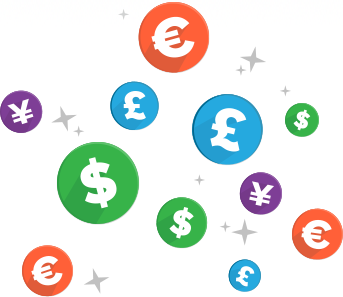The official currency of the Kingdom of Norway is Norwegian Krone. The Norwegian Krone was introduced to the country in 1875. The dependent regions of Norway such as the Svalbard, Bouvet Island,
Queen Maud Land and Peter I Island also use the Norway currency - Nok. Not long ago, Nok had been one of the most traded currencies in the world.
The Norwegian currency is in the subdivision of 100 øre. The currency is produced by Norges Bank, the Bank of Norway. Since there are no coins with a lower value to the 1 Norwegian Krone piece, prices are rounded up to the neatest whole number.
Some facts that you ought to know about the Norwegian Krone:
1. The short name for Norway currency is NOK.
2. KR is the symbol of this currency.
3. Most frequently used coins are 1 KR, 5 KR, 10 KR, 20 KR.
4. The most frequently used banknotes are 50 KR, 100 KR, 200 KR, 500 KR, 1000 KR.
History of Norwegian Krone
Norway is one of the wealthiest countries in the world with stable economic conditions. The Norwegian Krone is the official currency of Norway which is managed and administered by the Central Bank of Norway known as Norges Bank. Looking at Norwegian Krone's long and engaging history will definitely be worthwhile. So let's dig deeper.
Norwegian Speciedaler was the currency of the country prior to the introduction of the Krone (known as Crown in English). Norwegian Krone is coded as Kr. 100 ore makes one Krone. Back in 1873, the Scandinavian Monetary Union was formed and Norway too became a part of it. It was after joining the Scandinavian Union that Norwegian Speciedaler was dropped and Krone was adopted. Later in 1914, the union came to an end during the onset of the first world war. At that time, the union used Krone for the gold standard but in 1931, this standard was dismissed. However, Norway continued to use the gold standard for its Krone. When the world war ended, Krone was pegged to the British pound (20 Krone=1 Pound).
Later on, in 1939, Krone was pegged to the US Dollar and during the second world war, Krone got pegged to German Reichsmark. Finally, by 1992, this fixed exchange rate of Krone was dismissed by the central bank of Norway and the floating exchange rate was adopted. Till now, the country follows a floating exchange rate to ensure a better economic status for Norway. The floating exchange rate was introduced since there was heavy speculation about Krone and in order to keep the economic mechanisms high and good, an end to the fixed exchange rate was announced.
Coins and banknotes, both are used for monetary transactions in Norway. Coins are of 1, 5, 10, and 20 denominations and banknote denominations are 50, 100, 200, 500, and 1000. Each Norwegian banknote has certain prominent Norwegian figures printed on it like scientists, artists, etc. The notes also contain information about the cultural contributions made by popular personalities. Norges Bank (Central Bank of Norway) was established in 1985 and the body is responsible for several economic functions of the country. The Norges Bank Act, of 1985 mentions the details of the bank's responsibilities. The Executive Board of the Norges Bank is the highest authority of the bank. It has 7 members each of who is appointed directly by the Norwegian monarch.
Factors Affecting the Exchange Rate of Norwegian Krone
Norway maintains a floating exchange rate and is currently not pegged to any other currency. So, there are several elements that contribute to the status of Krone's exchange rate in the international market. The primary of these include:
1. Interest Rates
The interest rates offered by the Norges Bank play a decisive role in the exchange rate of Krone. A higher interest rate means higher foreign investment in Norway and vice-versa. So, it is important for Norwegian banks to maintain a healthy relationship between inflation and interest rates to attract more and more economical investments in the country.
2. International oil prices
In Western Europe, Norway is a leading oil producer and exporter. So, international oil prices heavily impact the exchange rate of the Norwegian Krone. The petroleum sector of the country accounts for around 30% of the economic gains. And so, the impact of oil export is heavy. Natural gas and oil products are exported across various countries globally. A rise in the same means profit for the Norway economy and vice-versa.
3. Exports from Norway
Apart from being the leading Western European oil producer, the Norwegian economy is also a centre for the export of hydropower, fishing, and mining products. Germany, the United Kingdom, and Sweden are the leading trading countries of Norway. A high trading rate of products exported from Norway proves to be beneficial for the country and vice-versa.
4. Political conditions
Norway is a constitutional monarchy and thus the country has both a hereditary monarch and a constitutionally elected body. While the constitutional body makes the maximum impact on the country's overall performance, the monarch remains a representative and ceremonial body. Any country's international presence is primarily affected by its internal political and economic conditions. So, the political stability of the country is the reason why the exchange rate of the Krone is quite stable.
These are some of the common factors that affect the exchange rate of the Norwegian Krone. Most commonly, the currency is paired with USD and Euro in the international market for the purpose of trade and transactions. So far, the currency is considered to be quite stable and also ranks high. This is the reason why the country also has a good international presence. Although no other currency has ever been pegged to the Norwegian Krone, the value of the currency remains impressive.












